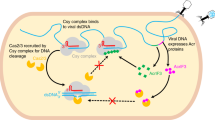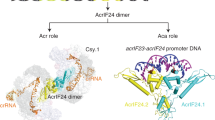Abstract
Bacteriophages encode anti-CRISPR suppressors to counteract the CRISPR/Cas immunity of their bacterial hosts, thus facilitating their survival and replication. Previous studies have shown that two phage-encoded anti-CRISPR proteins, AcrF1 and AcrF2, suppress the type I-F CRISPR/Cas system of Pseudomonas aeruginosa by preventing target DNA recognition by the Csy surveillance complex, but the precise underlying mechanism was unknown. Here we present the structure of AcrF1/2 bound to the Csy complex determined by cryo-EM single-particle reconstruction. By structural analysis, we found that AcrF1 inhibits target DNA recognition of the Csy complex by interfering with base pairing between the DNA target strand and crRNA spacer. In addition, multiple copies of AcrF1 bind to the Csy complex with different modes when working individually or cooperating with AcrF2, which might exclude target DNA binding through different mechanisms. Together with previous reports, we provide a comprehensive working scenario for the two anti-CRISPR suppressors, AcrF1 and AcrF2, which silence CRISPR/Cas immunity by targeting the Csy surveillance complex.
Similar content being viewed by others
Log in or create a free account to read this content
Gain free access to this article, as well as selected content from this journal and more on nature.com
or
Accession codes
Accessions
Electron Microscopy Data Bank
GenBank/EMBL/DDBJ
Protein Data Bank
References
Labrie SJ, Samson JE, Moineau S . Bacteriophage resistance mechanisms. Nat Rev Microbiol 2010; 8:317–327.
Barrangou R, Fremaux C, Deveau H, et al. CRISPR provides acquired resistance against viruses in prokaryotes. Science 2007; 315:1709–1712.
Jore MM, Brouns SJ, van der Oost J . RNA in defense: CRISPRs protect prokaryotes against mobile genetic elements. Cold Spring Harb Perspect Biol 2012 Jun 1. doi:10.1101/cshperspect.a003657
Bondy-Denomy J, Pawluk A, Maxwell KL, Davidson AR . Bacteriophage genes that inactivate the CRISPR/Cas bacterial immune system. Nature 2013; 493:429–432.
Pawluk A, Bondy-Denomy J, Cheung VH, Maxwell KL, Davidson AR . A new group of phage anti-CRISPR genes inhibits the type I-E CRISPR-Cas system of Pseudomonas aeruginosa. MBio 2014; 5:e00896.
Maxwell KL . Phages fight back: inactivation of the CRISPR-Cas bacterial immune system by anti-CRISPR proteins. PLoS Pathog 2016; 12:e1005282.
Chaudhary K, Chattopadhyay A, Pratap D . Anti-CRISPR proteins: counterattack of phages on bacterial defense (CRISPR/Cas) system. J Cell Physiol 2017 Mar 1. doi:10.1002/jcp.25877
Marraffini LA, Sontheimer EJ . CRISPR interference: RNA-directed adaptive immunity in bacteria and archaea. Nat Rev Genet 2010; 11:181–90.
Swarts DC, Mosterd C, van Passel MW, Brouns SJ . CRISPR interference directs strand specific spacer acquisition. PLoS One 2012; 7:e35888.
Yosef I, Goren MG, Qimron U . Proteins and DNA elements essential for the CRISPR adaptation process in Escherichia coli. Nucleic Acids Res 2012; 40:5569–5576.
Wang J, Li J, Zhao H, et al. Structural and mechanistic basis of PAM-dependent spacer acquisition in CRISPR-Cas systems. Cell 2015; 163:840–853.
Gesner EM, Schellenberg MJ, Garside EL, George MM, Macmillan AM . Recognition and maturation of effector RNAs in a CRISPR interference pathway. Nat Struct Mol Biol 2011; 18:688–692.
Sashital DG, Jinek M, Doudna JA . An RNA-induced conformational change required for CRISPR RNA cleavage by the endoribonuclease Cse3. Nat Struct Mol Biol 2011; 18:680–687.
Westra ER, van Erp PB, Kunne T, et al. CRISPR immunity relies on the consecutive binding and degradation of negatively supercoiled invader DNA by Cascade and Cas3. Mol Cell 2012; 46:595–605.
Huo Y, Nam K H, Ding F, et al. Structures of CRISPR Cas3 offer mechanistic insights into Cascade-activated DNA unwinding and degradation. Nat Struct Mol Biol 2014; 21:771–777.
Jiang F, Doudna JA . The structural biology of CRISPR-Cas systems. Curr Opin Struct Biol 2015; 30:100–111.
Jackson RN, Golden SM, van Erp PB, et al. Structural biology. Crystal structure of the CRISPR RNA-guided surveillance complex from Escherichia coli. Science 2014; 345:1473–1479.
Zhao H, Sheng G, Wang J, et al. Crystal structure of the RNA-guided immune surveillance Cascade complex in Escherichia coli. Nature 2014; 515:147–150.
Bondy-Denomy J, Garcia B, Strum S, et al. Multiple mechanisms for CRISPR-Cas inhibition by anti-CRISPR proteins. Nature 2015; 526:136–139.
Wang J, Ma J, Cheng Z, et al. A CRISPR evolutionary arms race: structural insights into viral anti-CRISPR/Cas responses. Cell Res 2016; 26:1165–1168.
Wang X, Yao D, Xu JG, et al. Structural basis of Cas3 inhibition by the bacteriophage protein AcrF3. Nat Struct Mol Biol 2016; 23:868–870.
Maxwell KL, Garcia B, Bondy-Denomy J, Bona D, Hidalgo-Reyes Y, Davidson AR . The solution structure of an anti-CRISPR protein. Nat Commun 2016; 7:13134.
Chowdhury S, Carter J, Rollins MF, et al. Structure reveals mechanisms of viral suppressors that intercept a CRISPR RNA-guided surveillance complex. Cell 2017; 169:47–57.
Taylor DW, Zhu Y, Staals RH, et al. Structural biology. Structures of the CRISPR-Cmr complex reveal mode of RNA target positioning. Science 2015; 348:581–585.
Wiedenheft B, Lander GC, Zhou K, et al. Structures of the RNA-guided surveillance complex from a bacterial immune system. Nature 2011; 477:486–489.
Jore MM, Lundgren M, van Duijn E, et al. Structural basis for CRISPR RNA-guided DNA recognition by Cascade. Nat Struct Mol Biol 2011; 18:529–536.
Jun JW, Kim HJ, Yun SK, Chai JY, Park SC . Eating oysters without risk of vibriosis: application of a bacteriophage against Vibrio parahaemolyticus in oysters. Int J Food Microbiol 2014; 188:31–35.
Jun JW, Shin TH, Kim JH, et al. Bacteriophage therapy of a Vibrio parahaemolyticus infection caused by a multiple-antibiotic-resistant O3:K6 pandemic clinical strain. J Infect Dis 2014; 210:72–78.
Skurnik M, Kiljunen S . Possibilities of bacteriophage therapy. Duodecim 2016; 132:712–719.
Xu Y, Liu Y, Liu Y, Pei J, Yao S, Cheng C . Bacteriophage therapy against Enterobacteriaceae. Virol Sin 2015; 30:11–18.
Grant T, Grigorieff N . Automatic estimation and correction of anisotropic magnification distortion in electron microscopes. J Struct Biol 2015; 192:204–208.
Li X, Mooney P, Zheng S, et al. Electron counting and beam-induced motion correction enable near-atomic-resolution single-particle cryo-EM. Nat Methods 2013; 10:584–590.
Rohou A, Grigorieff N . CTFFIND4: fast and accurate defocus estimation from electron micrographs. J Struct Biol 2015; 192:216–221.
Tang G, Peng L, Baldwin PR, et al. EMAN2: an extensible image processing suite for electron microscopy. J Struct Biol 2007; 157:38–46.
Scheres SH . RELION: implementation of a Bayesian approach to cryo-EM structure determination. J Struct Biol 2012; 180:519–530.
Kimanius D, Forsberg BO, Scheres SH, Lindahl E . Accelerated cryo-EM structure determination with parallelisation using GPUs in RELION-2. Elife 2016 Nov 15. doi:10.7554/eLife.18722
Kucukelbir A, Sigworth FJ, Tagare HD . Quantifying the local resolution of cryo-EM density maps. Nat Methods 2014; 11:63–65.
Emsley P, Lohkamp B, Scott WG, Cowtan K . Features and development of Coot. Acta Crystallogr D Biol Crystallogr 2010; 66:486–501.
Wriggers W, Milligan RA, McCammon JA . Situs: a package for docking crystal structures into low-resolution maps from electron microscopy. J Struct Biol 1999; 125:185–195.
Pettersen EF, Goddard TD, Huang CC, et al. UCSF Chimera — a visualization system for exploratory research and analysis. J Comput Chem 2004; 25:1605–1612.
Trabuco LG, Villa E, Schreiner E, Harrison CB, Schulten K . Molecular dynamics flexible fitting: a practical guide to combine cryo-electron microscopy and X-ray crystallography. Methods 2009; 49:174–180.
Adams PD, Afonine PV, Bunkoczi G, et al. PHENIX: a comprehensive Python-based system for macromolecular structure solution. Acta Crystallogr D Biol Crystallogr 2010; 66:213–221.
Chen VB . Arendall WB 3rd, Headd JJ, et al. MolProbity: all-atom structure validation for macromolecular crystallography. Acta Crystallogr D Biol Crystallogr 2010; 66:12–21.
DeLano WL PyMOL molecular graphics system. 2002. Available from: URL: http://www.pymol.org.
Acknowledgements
We thank all staffs at the National Center for Protein Science Shanghai (NCPSS) cryo-EM department and Xiaojun Huang, Gang Ji and other staffs at the Center of Biological Imaging (IBP, Chinese Academy of Sciences (CAS)) for assistance with data collection. We are grateful to Dr Guopeng Wang (The Core Facilities at School of Life Sciences, Peking University) and Dr Tie Yang (The State Key Laboratory of Membrane Biology, Institute of Zoology, CAS, Beijing) for technical support in electron microscope operation. This study was supported by the Strategic Priority Research Program of CAS (XDB08020100), the Ministry of Science and Technology of China (973 Project; 2013CB531502 and 2014CB542503). YS is supported by the Excellent Young Scientist Program from the National Natural Science Foundation of China (NSFC; 81622031), the Excellent Young Scientist Program of CAS and the Youth Innovation Promotion Association CAS (2015078). GFG is supported partly as a leading principal investigator of the NSFC Innovative Research Group (81621091).
Author information
Authors and Affiliations
Corresponding authors
Additional information
( Supplementary information is linked to the online version of the paper on the Cell Research website.)
Supplementary information
Supplementary information, Figure S1
Size exclusion chromatogram and SDS-PAGE profiles of AcrF1/2-Csy32nt complex and AcrF1/2-Csy20nt complex. (PDF 148 kb)
Supplementary information, Figure S2
Cryo-EM analysis of AcrF1/2-Csy32nt complex. (PDF 211 kb)
Supplementary information, Figure S3
Major image processing workflow of AcrF1/2-Csy32nt complex. (PDF 127 kb)
Supplementary information, Figure S4
Cryo-EM analysis of AcrF1/2-Csy20nt complex. (PDF 202 kb)
Supplementary information, Figure S5
Major image processing workflow of AcrF1/2-Csy20nt complex. (PDF 140 kb)
Supplementary information, Figure S6
Local resolution distribution patterns of the four reconstructions used in structural analysis. (PDF 148 kb)
Supplementary information, Figure S7
Superposition of Csy3 backbone densities of AcrF1/2-Csy complex reconstructions and the self-assembly of Csy3 subunits. (PDF 170 kb)
Supplementary information, Figure S8
Close up views of AcrF1 binding interfaces at different binding modes. (PDF 125 kb)
Supplementary information, Table S1
Statistics of the structural models of Csy3-crRNA32nt-AcrF1 and Csy3-crRNA20nt-AcrF1 sub-complexes refined against the 3.8 Å and 4.2 Å resolution cryo-EM maps. (PDF 13 kb)
Rights and permissions
About this article
Cite this article
Peng, R., Xu, Y., Zhu, T. et al. Alternate binding modes of anti-CRISPR viral suppressors AcrF1/2 to Csy surveillance complex revealed by cryo-EM structures. Cell Res 27, 853–864 (2017). https://doi.org/10.1038/cr.2017.79
Received:
Revised:
Accepted:
Published:
Issue date:
DOI: https://doi.org/10.1038/cr.2017.79
Keywords
This article is cited by
-
Insights into the inhibition of protospacer integration via direct interaction between Cas2 and AcrVA5
Nature Communications (2024)
-
Anti-CRISPR proteins: a weapon of phage-bacterial arm race for genome editing
The Nucleus (2024)
-
Bacteriophages suppress CRISPR–Cas immunity using RNA-based anti-CRISPRs
Nature (2023)
-
Disarming of type I-F CRISPR-Cas surveillance complex by anti-CRISPR proteins AcrIF6 and AcrIF9
Scientific Reports (2022)
-
Insights into the inhibition of type I-F CRISPR-Cas system by a multifunctional anti-CRISPR protein AcrIF24
Nature Communications (2022)



